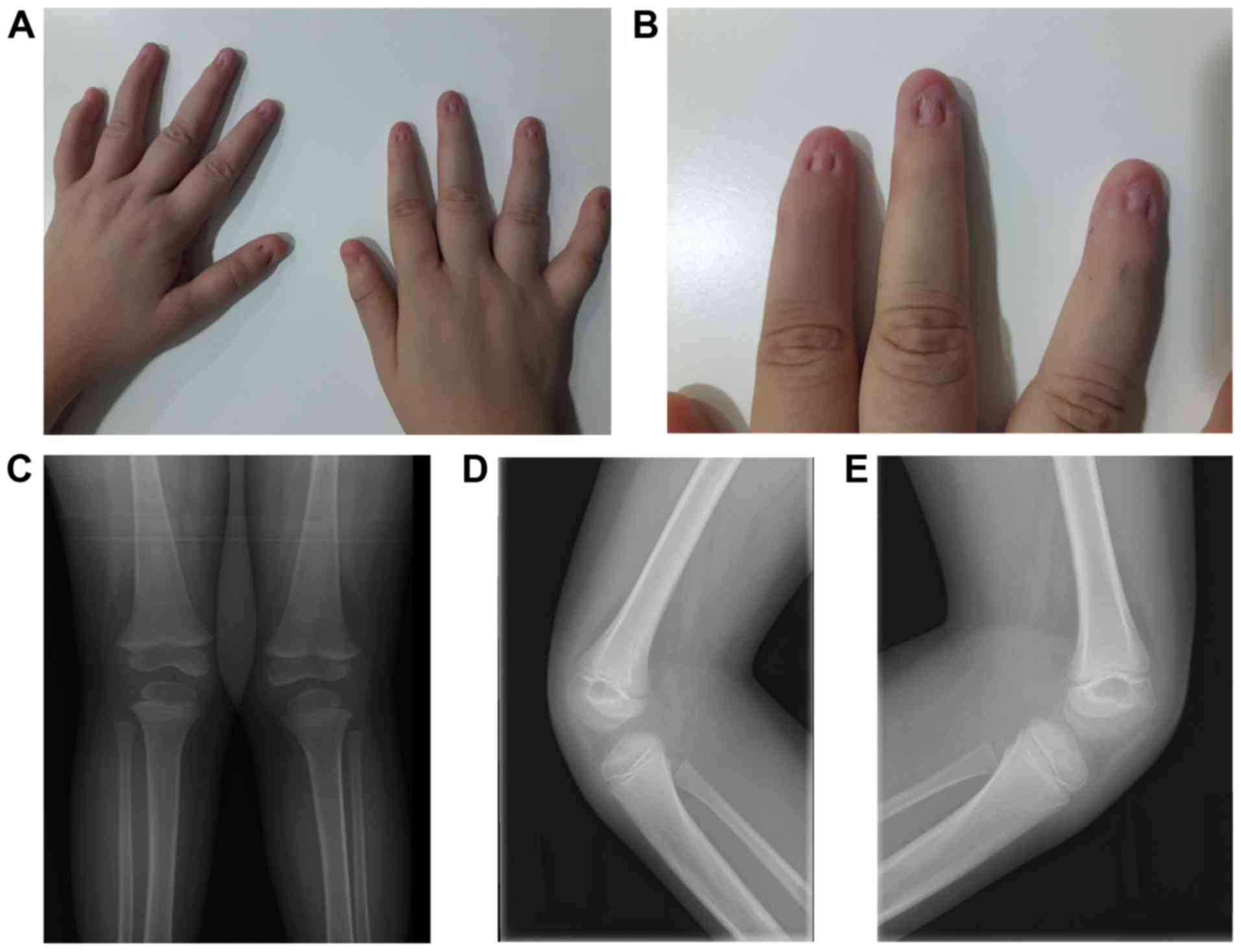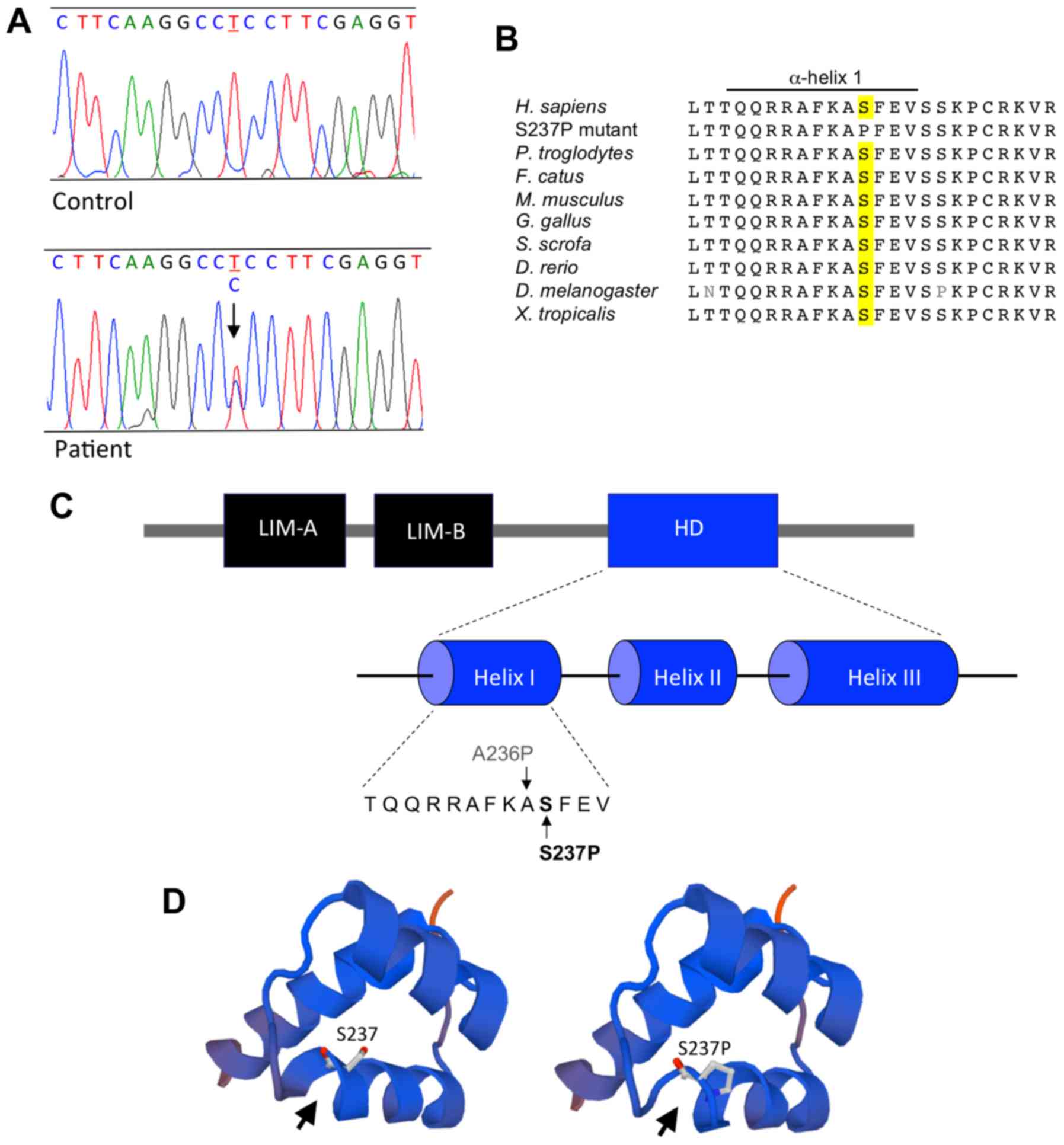|
1
|
Witzgall R: Nail-patella syndrome.
Pflugers Arch. 469:927–936. 2017.
|
|
2
|
McIntosh I, Dunston JA, Liu L, Hoover-Fong
JE and Sweeney E: Nail patella syndrome revisited: 50 years after
linkage. Ann Hum Genet. 69:349–363. 2005.PubMed/NCBI View Article : Google Scholar
|
|
3
|
Lemley KV: Kidney disease in nail-patella
syndrome. Pediatr Nephrol. 24:2345–2354. 2009.PubMed/NCBI View Article : Google Scholar
|
|
4
|
Lichter PR, Richards JE, Downs CA,
Stringham HM, Boehnke M and Farley FA: Cosegregation of open-angle
glaucoma and the nail-patella syndrome. Am J Ophthalmol.
124:506–515. 1997.PubMed/NCBI View Article : Google Scholar
|
|
5
|
Dreyer SD, Zhou G, Baldini A, Winterpacht
A, Zabel B, Cole W, Johnson RL and Lee B: Mutations in LMX1B cause
abnormal skeletal patterning and renal dysplasia in nail patella
syndrome. Nat Genet. 19:47–50. 1998.PubMed/NCBI View Article : Google Scholar
|
|
6
|
McIntosh I, Dreyer SD, Clough MV, Dunston
JA, Eyaid W, Roig CM, Montgomery T, Ala-Mello S, Kaitila I,
Winterpacht A, et al: Mutation analysis of LMX1B gene in
nail-patella syndrome patients. Am J Hum Genet. 63:1651–1658.
1998.PubMed/NCBI View
Article : Google Scholar
|
|
7
|
Vollrath D, Jaramillo-Babb VL, Clough MV,
McIntosh I, Scott KM, Lichter PR and Richards JE: Loss-of-function
mutations in the LIM-homeodomain gene, LMX1B, in nail-patella
syndrome. Hum Mol Genet. 7:1091–1098. 1998.PubMed/NCBI View Article : Google Scholar
|
|
8
|
Bongers EM, Huysmans FT, Levtchenko E, de
Rooy JW, Blickman JG, Admiraal RJ, Huygen PL, Cruysberg JR, Toolens
PA, Prins JB, et al: Genotype-phenotype studies in nail-patella
syndrome show that LMX1B mutation location is involved in the risk
of developing nephropathy. Eur J Hum Genet. 13:935–946.
2005.PubMed/NCBI View Article : Google Scholar
|
|
9
|
Marini M, Bocciardi R, Gimelli S, Di Duca
M, Divizia MT, Baban A, Gaspar H, Mammi I, Garavelli L, Cerone R,
et al: A spectrum of LMX1B mutations in Nail-Patella syndrome: New
point mutations, deletion, and evidence of mosaicism in unaffected
parents. Genet Med. 12:431–439. 2010.PubMed/NCBI View Article : Google Scholar
|
|
10
|
Hamlington JD, Jones C and McIntosh I:
Twenty-two novel LMX1B mutations identified in nail patella
syndrome (NPS) patients. Hum Mutat. 18(458)2001.PubMed/NCBI View Article : Google Scholar
|
|
11
|
Ghoumid J, Petit F, Holder-Espinasse M,
Jourdain AS, Guerra J, Dieux-Coeslier A, Figeac M, Porchet N,
Manouvrier-Hanu S and Escande F: Nail-Patella Syndrome: Clinical
and molecular data in 55 families raising the hypothesis of a
genetic heterogeneity. Eur J Hum Genet. 24:44–50. 2016.PubMed/NCBI View Article : Google Scholar
|
|
12
|
Dreyer SD, Morello R, German MS, Zabel B,
Winterpacht A, Lunstrum GP, Horton WA, Oberg KC and Lee B: LMX1B
transactivation and expression in nail-patella syndrome. Hum Mol
Genet. 9:1067–1074. 2000.PubMed/NCBI View Article : Google Scholar
|
|
13
|
Sato U, Kitanaka S, Sekine T, Takahashi S,
Ashida A and Igarashi T: Functional characterization of LMX1B
mutations associated with nail-patella syndrome. Pediatr Res.
57:783–788. 2005.PubMed/NCBI View Article : Google Scholar
|
|
14
|
Claverie-Martin F, Trindade A,
Garcia-Gonzalez NC and Callejon AC: Novel missense mutation
affecting the LIM-A domain of LMX1B in a family with Nail-Patella
syndrome. Intractable Rare Dis Res. 8:14–19. 2019.PubMed/NCBI View Article : Google Scholar
|
|
15
|
Lee BH, Cho TJ, Choi HJ, Kang HK, Lim IS,
Park YH, Ha IS, Choi Y and Cheong HI: Clinico-genetic study of
nail-patella syndrome. J Korean Med Sci. 24 (Suppl 1):S82–S86.
2009.PubMed/NCBI View Article : Google Scholar
|
|
16
|
Kopanos C, Tsiolkas V, Kouris A, Chapple
CE, Albarca Aguilera M, Meyer R and Massouras A: VarSome: The human
genomic variant search engine. Bioinformatics. 35:1978–1980.
2019.PubMed/NCBI View Article : Google Scholar
|
|
17
|
Richards S, Aziz N, Bale S, Bick D, Das S,
Gastier-Foster J, Grody WW, Hegde M, Lyon E, Spector E, et al:
Standards and guidelines for the interpretation of sequence
variants: A joint consensus recommendation of the American college
of medical genetics and genomics and the association for molecular
pathology. Genet Med. 17:405–424. 2015.PubMed/NCBI View Article : Google Scholar
|
|
18
|
Bongers EM, Gubler MC and Knoers NV:
Nail-patella syndrome. Overview on clinical and molecular findings.
Pediatr Nephrol. 17:703–712. 2002.PubMed/NCBI View Article : Google Scholar
|
|
19
|
Burghardt T, Kastner J, Suleiman H,
Rivera-Milla E, Stepanova N, Lottaz C, Kubitza M, Böger CA, Schmidt
S, Gorski M, et al: LMX1B is essential for the maintenance of
differentiated podocytes in adult kidneys. J Am Soc Nephrol.
24:1830–1848. 2013.PubMed/NCBI View Article : Google Scholar
|
|
20
|
Chen H, Lun Y, Ovchinnikov D, Kokubo H,
Oberg KC, Pepicelli CV, Gan L, Lee B and Johnson RL: Limb and
kidney defects in Lmx1b mutant mice suggest an involvement of LMX1B
in human nail patella syndrome. Nat Genet. 19:51–55.
1998.PubMed/NCBI View Article : Google Scholar
|
|
21
|
Pressman CL, Chen H and Johnson RL: LMX1B,
a LIM homeodomain class transcription factor, is necessary for
normal development of multiple tissues in the anterior segment of
the murine eye. Genesis. 26:15–25. 2000.PubMed/NCBI
|
|
22
|
Chi YI: Homeodomain revisited: A lesson
from disease-causing mutations. Hum Genet. 116:433–444.
2005.PubMed/NCBI View Article : Google Scholar
|
|
23
|
Knoers NV, Bongers EM, van Beersum SE,
Lommen EJ, van Bokhoven H and Hol FA: Nail-patella syndrome:
Identification of mutations in the LMX1B gene in Dutch families. J
Am Soc Nephrol. 11:1762–1766. 2000.PubMed/NCBI
|
















